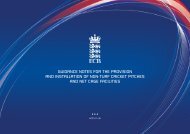TS2 - Cricket Specific Indoor Centres - Ecb - England and Wales ...
TS2 - Cricket Specific Indoor Centres - Ecb - England and Wales ...
TS2 - Cricket Specific Indoor Centres - Ecb - England and Wales ...
You also want an ePaper? Increase the reach of your titles
YUMPU automatically turns print PDFs into web optimized ePapers that Google loves.
<strong>Cricket</strong> <strong>Specific</strong><strong>Indoor</strong> <strong>Centres</strong><strong>TS2</strong>ECB Facility Briefs <strong>and</strong> GuidanceNotes for <strong>Cricket</strong> <strong>Specific</strong> <strong>Indoor</strong><strong>Centres</strong> (Excellence <strong>Centres</strong>)
<strong>Cricket</strong> <strong>Specific</strong><strong>Indoor</strong> <strong>Centres</strong>For any new build or upgraded <strong>Cricket</strong> <strong>Specific</strong> CentreIn recent years several <strong>Cricket</strong> specific centres have been built,notably at Lords (MCC), Trent Bridge (Nottinghamshire CCC),Sophia Gardens,Cardiff (Glamorgan CCC) <strong>and</strong> the George AbbottSchool, Guildford (Surrey CCC). These were built primarily toservice cricket, mainly out of season.Specialist centres such as the above are expensive to build <strong>and</strong>without combining with other sports programming time,expensiveto maintain.Therefor, if necessary, indoor cricket schools should bedesigned with multiple use in mind.This will affect the design ofthe proposed centre, making the production of a comprehensivedesign brief an essential part of the planning stage.However, many cricket specific centres are well established <strong>and</strong>would require only an up grading of the current facility to achievethe recommended minimum requirements.It is essential that certain Critical Factors be identified when installationtakes place:■ Flooring which plays well, is hardwearing, physically comfortable <strong>and</strong>safe for bowlers. (see ECB Technical Performance <strong>Specific</strong>ation forArtificial Surfaces).■ Has a quality lighting system.■ A flexible <strong>and</strong> efficient netting system for coaching variations.■ Canvas ‘blinkers’ to stiffen side <strong>and</strong> end netting for safety <strong>and</strong> toprovide better sighting of the ball.■ A well lit back wall, to act as sightscreen.■ Adequate storage. (Too make safe <strong>and</strong> secure coaching area).■ Social area <strong>and</strong> control point .■ Adequate changing <strong>and</strong> toilet facilities■ Ancillary rooms.The following lists suggest recommended minimum requirementsfor a <strong>Cricket</strong> <strong>Specific</strong> <strong>Indoor</strong> Centre but it must be stressed that itis prudent to provide a facility to the best specification possible:Net LanesThe overall dimensions of a cricket specific hall will determine thenumber of bays with the following being suggested:■ 4- 6 Lanes. (If current buildings offer less but cater for cricketsdem<strong>and</strong> <strong>and</strong> or planning regulations will limit either new build orupgrade then these local conditions prevail).■ 16-20 m available for bowlers run-up.■ Flooring to meet ECB Technical Performance <strong>Specific</strong>ation forArtificial Surfaces. Technical TS-6 (i)(ii).■ The outside back <strong>and</strong> side netting must be suspended to give aminimum of 1m clear space between the building walls <strong>and</strong> netting toallow for safety <strong>and</strong> access.Dimensions for a Single Net BayMultiples of the following are dependent on the overall size of thehall to determine the number of net bays: (see fig.1).Minimum Recommended MaximumSafety Margin (surrounds) 1mWidth 3.66m 4mLength 37.12m 41.12mHeight of Horizontal top net 4m 5mNetting <strong>and</strong> BlinkersNettingThe individual net bay is separated from the adjoining bays bytracked side nets extending from end to end. The most efficientmethod is by independent overhead tracks, which allows nets to bedrawn independently <strong>and</strong> which allows for flexible usage.■ It is recommended that nets be suspended from a heavy-dutyaluminum tracking <strong>and</strong> trolley system, which conforms to BS.1892.This type of system requires an independent overhead net, underwhich the tracking system is fixed.There must be no space betweenthe roof netting <strong>and</strong> the tracking system through which the ballcould pass from net to net.
Figure 1.Space diagram – a multi-wicketnetted area, with Attached canvasblinkers <strong>and</strong> integral roof netting.BlinkersBlinkers must be fitted to all practice nets. Either heavy duty whitecanvas or nylon,they should be suspended on both sides of the batsman.■ It is recommended that the blinkers should extend at least 3m in frontof the batsman, 5m from the rear net, <strong>and</strong> at a minimum height of1.8m. (see fig 1).■ It is recommended that white nylon is used in the roof netting <strong>and</strong> iseither sewn in or roof fitted with, 50mm knot to knot, (2”) squaremesh, with the leading edges taped for reinforcement.The side netting should be long enough for at least 0.3m ofslack/drape to rest upon the floor.This creates added weight <strong>and</strong>prevents the net from billowing out when struck by the ball, thusinterfering with adjacent nets.This is essential for safety.Additional weighting could be added to the base of the netting(lead line).■ It is recommended that 48mm white nylon mesh be used.( 50mm (2”)square knot to knot).■ All sports hall netting, canvas, storage pouches, etc. should be madeof a fire retardant material in accordance with BS 5867 Part 2.■ All netting should be sound, not allowing balls through, under or out ofthe net area.■ The netting should not be tight thus making balls rebound dangerously.A similar system is recommended for the back netting behind thebowler to create a good visual background <strong>and</strong> safety against ballsdriven down the net bay.■ It is recommended that the bowling end blinker be 3m(9’9”) higheither as a Velcro attachment or sewn in to the netting.Playing surfaceThe choice of floor surface is critical <strong>and</strong> above all should be chosenin accordance to its performance characteristics. Whether it is amulti-sport surface or rollout mat, it should perform well in termsof resilience, stiffness, friction <strong>and</strong> resistance to wear. (See ECBTechnical <strong>Specific</strong>ation TS-6 (i)(ii)).The flooring chosen should be one that can be repaired orreplaced without any effect on its playing characteristics, such asspin, pace <strong>and</strong> bounce.The flooring may be a polymer sheeting orcarpet,laid on a concrete screed.The wear characteristics of sheetingare generally superior to those of carpets.An added advantage is thatthe density <strong>and</strong> thickness of polymer can be varied to give differingplaying characteristics.The installation of permanent underlays tothe continuous surface <strong>and</strong>/or the use of temporary rollout mats canalso vary the latter.Before making a final choice of surface,obtain test results indicatingthe performance of various product combinations. (See ECBTechnical <strong>Specific</strong>ation TS-6 (i)(ii)).If there is no alternative to using rollout mats, it should be firmwith no extra cushioning, otherwise a combination of a subsurface<strong>and</strong> mat will seriously affect the ball bounce.
Set out below are the suggested minimum requirements for a<strong>Cricket</strong> <strong>Specific</strong> <strong>Indoor</strong> Centre:■ Flooring to meet ECB Technical Performance <strong>Specific</strong>ation forArtificial Surfaces.■ Additional spin mats if available <strong>and</strong> required.■ Bowlers shock pads in each lane through out crease area <strong>and</strong> for aminimum of 3m into follow through strides.■ Batting <strong>and</strong> Bowling creases marked in each lane.■ Full-length match pitch with bowlers shock pads to be marked in thecentre of the hall.(this facility is dependant on the layout <strong>and</strong> size of hall).LightingIt is essential to have good quality lighting so that the players canfollow the movement of the ball travelling at speeds of up to 80mph,having been struck by the batsman or bowled by the bowler.The batsman must sight clearly the bowler throughout allelements of the run-up <strong>and</strong> delivery <strong>and</strong> the ball through its flight,with the bowler having a clear view of the pitch.Glare or brightnessof the lighting system must not distract the sight lines of both.The illuminance must be uniform throughout the hall, with thebackground walls behind both batsman <strong>and</strong> bowler providing a goodviewing contrast. It is a mistake to economise on lighting, firstly assafety is paramount <strong>and</strong> secondly due to the specialist nature ofcricket <strong>and</strong> the propulsion of balls at speed.The lighting system musttherefor take into account the specialist nature of the game.■ It is recommended that the minimum lighting level for a <strong>Cricket</strong><strong>Specific</strong> Sports Hall be between 1000-1500 Lux with a UniformityRatio (min/ave) 0.8.These requirements can generally be met by a system of a numberof horizontal, fluorescent luminaires, fitted with reflectors <strong>and</strong>mounted at right angles to the pitch.The reflectors must screen bothbatsman <strong>and</strong> bowler from direct view of this light source.<strong>Cricket</strong> <strong>Specific</strong> Ancillary Equipment <strong>and</strong> AccommodationDue to the <strong>Cricket</strong> specific usage of the centre a certain percentageof programming time will be allocated to the development ofexcellence,although that is by no means to say that all levels of cricketshould not benefit from the ancillary cricket coaching equipment.However, it is recommended that a <strong>Cricket</strong> <strong>Specific</strong> <strong>Indoor</strong> <strong>Centres</strong>hould have the following minimum equipment:■ Video recording camera in one lane positioned at the front <strong>and</strong> rear ofa net bay <strong>and</strong> also at right angles to the batting <strong>and</strong> bowling crease.■ At least 1 bowling machine.With regard to ancillary accommodation, the following is asuggested minimum requirement:■ Reception area - depending on the centres usage will determine howelaborate this area needs to be. I.e. An office may or may not berequired.■ Storage - a secure room for equipment <strong>and</strong> coaching aids,remembering that storage requirement normally increase with time.■ Changing area - the size of the changing area will depend on thenumber of practice bays <strong>and</strong> the proposed timetable for usage.However for cricket specific purposes calculations should be based on6/7 players per net with female provision needed both for cricket <strong>and</strong> ifa multi-sport programme is envisaged.■ Video playback room / lecture room with a minimum capacity of 40people.■ First Aid <strong>and</strong> Physiotherapy room.■ Fitness room.Access for Disabled PeopleAll sports facilities should be accessible to the whole populationincluding people with disabilities. For further guidance please refer tothe separate Sport <strong>Engl<strong>and</strong></strong> Guidance Note:Access for Disabled People.Further AdviceThere are a number of Sport <strong>Engl<strong>and</strong></strong> Guidance notes on relatedmatters.A current list is available from:Sport <strong>Engl<strong>and</strong></strong> Publications, PO Box 255,Whetherby LS23 7LZ.Telephone 0990 210255. Fax 0990 210266.ECB DisclaimerEvery effort has been made to ensure the accuracy contained withinthis publication.The <strong>Engl<strong>and</strong></strong> <strong>and</strong> <strong>Wales</strong> <strong>Cricket</strong> Board, its staff orconsultants,shall not at any time,be held responsible or liable to anyparty in respect of any loss, damage or costs arising directly orindirectly from reliance placed on the material set out in thispublication which is for guidance only <strong>and</strong> should not be taken asa substitute for expert professional advice <strong>and</strong> assistance.



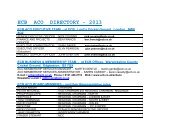
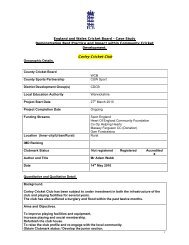
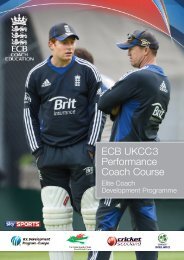
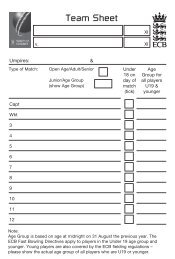
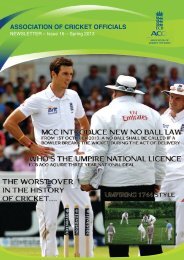
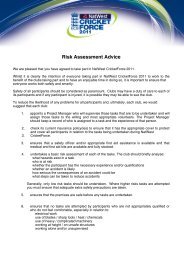
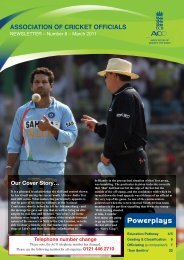


![Indoor Sports Halls with Cricket Provision [TS3] - Ecb - England and ...](https://img.yumpu.com/49070696/1/190x135/indoor-sports-halls-with-cricket-provision-ts3-ecb-england-and-.jpg?quality=85)

